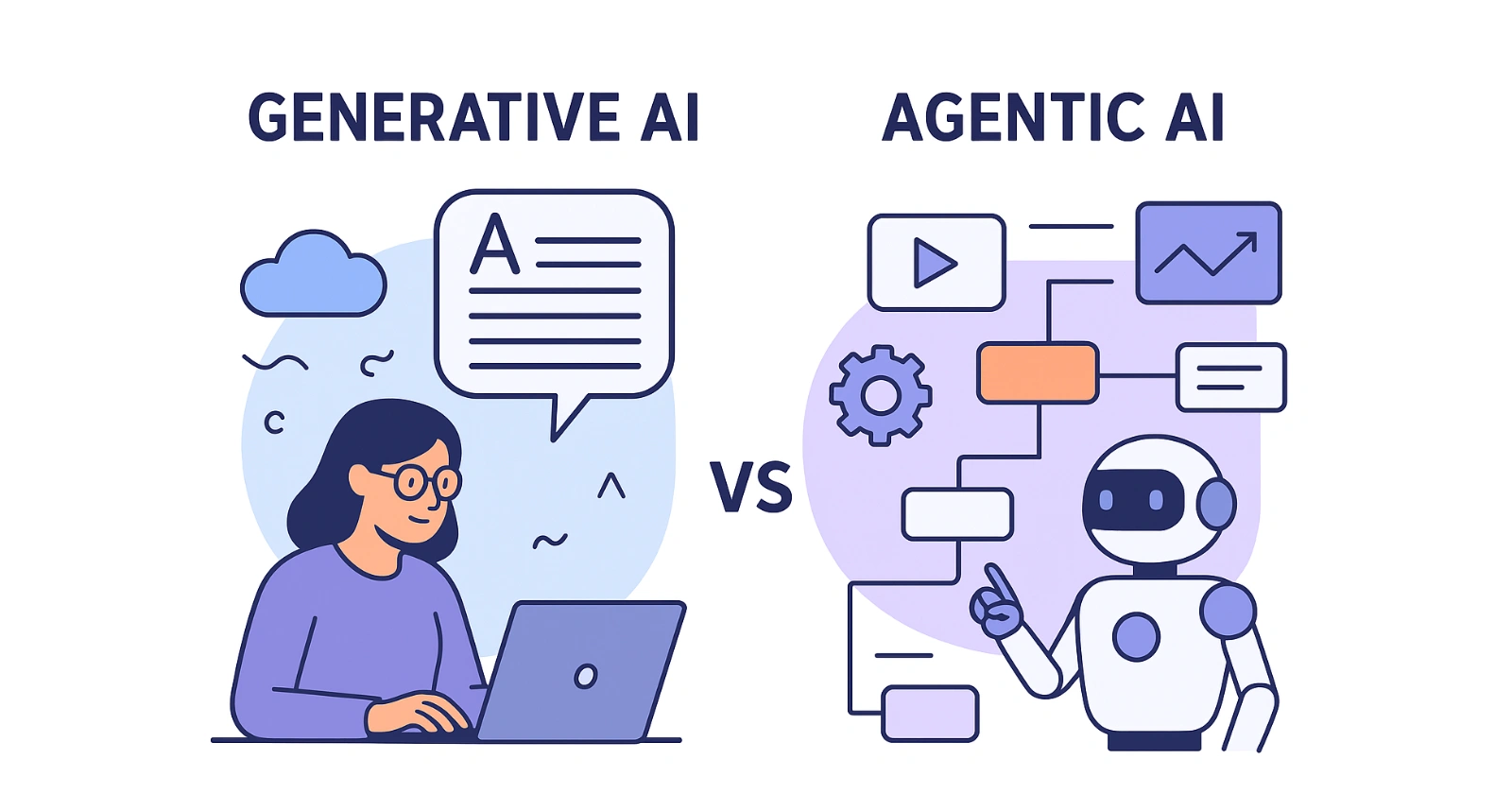The rapid evolution of artificial intelligence (AI) has ushered in a new era of innovation, transforming how businesses operate and individuals interact with technology. Two distinct branches, generative AI and agentic AI, are at the forefront of this transformation.
Generative AI captivates with its ability to create original content, from vivid images to sophisticated code, while agentic AI empowers systems to act autonomously, making decisions and executing complex tasks with minimal human intervention. Both technologies are redefining industries, streamlining workflows, and unlocking new possibilities.
The rise of generative AI has democratized creativity, enabling professionals and hobbyists alike to produce high-quality content with unprecedented ease. Meanwhile, agentic AI is pushing boundaries by automating intricate processes, from supply chain optimization to personalized customer experiences.
Understanding their unique applications and complementary strengths is essential for leveraging their full potential. This exploration delves into the transformative use cases of both technologies, highlighting their impact across diverse sectors.
As organizations race to integrate AI into their operations, the distinct capabilities of generative and agentic AI offer tailored solutions to modern challenges.
From enhancing customer engagement to revolutionizing software development, these technologies are not just tools but catalysts for innovation. This comprehensive guide examines their applications, key differences, and real-world examples, providing a roadmap for harnessing their power effectively.
Understanding Generative AI: The Art of Creation
Generative AI specializes in producing original content based on patterns learned from vast datasets. Powered by large language models (LLMs), deep learning algorithms, and generative adversarial networks (GANs), it excels at creating text, images, videos, audio, and code in response to user prompts. Its reactive nature means it thrives on specific inputs, delivering outputs tailored to user requests.
Key Features of Generative AI
Generative AI stands out for its versatility in content creation and data analysis. It can craft compelling narratives, generate realistic visuals, or even produce functional code snippets. Its adaptability allows it to refine outputs based on feedback, making it a powerful tool for personalized experiences. Additionally, its ability to analyze large datasets uncovers trends and patterns, driving insights in fields like marketing and supply chain management.
Top Generative AI Use Cases
Generative AI’s applications span multiple industries, each leveraging its creative prowess to enhance efficiency and engagement.
Content Creation for SEO and Marketing
Businesses harness generative AI to produce SEO-optimized content, such as blog posts and landing pages, to boost organic traffic. For example, a digital marketing agency might use tools like Jasper or ChatGPT to create keyword-rich articles that rank higher on search engines, attracting more visitors. This approach saves time and ensures consistency in tone and style across campaigns.
Product Design and Innovation
Generative AI accelerates product development by generating design concepts based on market trends and consumer preferences. In the fashion industry, companies like Adidas use AI tools to create clothing designs, iterating quickly based on customer feedback and data analysis. This reduces development cycles and enhances market responsiveness.
Customer Support Automation
Chatbots powered by generative AI handle routine customer inquiries, providing instant responses to questions about order status or refunds. E-commerce platforms like Shopify integrate AI-driven chatbots to streamline customer interactions, improving satisfaction while reducing the workload on human agents.
Code Generation and Software Development
Developers use generative AI tools like GitHub Copilot to write code snippets, debug programs, and automate repetitive tasks. This capability empowers both seasoned programmers and novices to build applications faster, enhancing productivity and innovation in software development.
Synthetic Data Generation
When real-world data is scarce or sensitive, generative AI creates synthetic datasets for training machine learning models. In healthcare, synthetic patient data enables researchers to develop algorithms without compromising privacy, ensuring compliance with regulations like HIPAA.
| Generative AI Use Case | Industry | Example Application |
|---|---|---|
| Content Creation | Marketing | SEO-optimized blog posts |
| Product Design | Fashion | AI-generated clothing designs |
| Customer Support | E-commerce | AI-powered chatbots |
| Code Generation | Tech | Automated coding with GitHub Copilot |
| Synthetic Data | Healthcare | Privacy-safe data for research |
Exploring Agentic AI: The Power of Autonomy
Agentic AI takes automation to new heights by enabling systems to make decisions, plan, and execute tasks independently. Unlike generative AI, which responds to prompts, agentic AI operates proactively, using LLMs, reinforcement learning, and external tools to achieve complex goals. Its ability to adapt to changing environments makes it ideal for dynamic, multi-step processes.
Key Features of Agentic AI
Agentic AI’s hallmark is its autonomy, allowing it to perceive, reason, act, and learn. It integrates with external systems via APIs, processes real-time data, and adjusts strategies dynamically. Its problem-solving capabilities and interactivity make it a game-changer for industries requiring independent operation, such as logistics and finance.
Top Agentic AI Use Cases
Agentic AI’s applications focus on automation and decision-making, transforming workflows in high-stakes environments.
Customer Service Automation
Agentic AI enhances customer service by autonomously handling complex interactions. For instance, a telecom company might deploy an AI agent to resolve billing disputes by retrieving account details, analyzing usage patterns, and proposing solutions without human intervention. This improves response times and customer satisfaction.
Healthcare Workflow Optimization
In healthcare, agentic AI streamlines administrative tasks and enhances patient care. Propeller Health’s smart inhalers, for example, use agentic AI to monitor medication usage and environmental factors, alerting providers to potential issues. This proactive approach improves patient outcomes and reduces manual oversight.
Supply Chain and Logistics
Agentic AI optimizes supply chains by autonomously managing inventory, reordering supplies, and adjusting delivery routes. A logistics firm like DHL could use agentic AI to reroute shipments in real time based on traffic or weather conditions, ensuring timely deliveries and cost efficiency.
Financial Risk Management
Financial institutions leverage agentic AI to monitor market trends and adjust investment strategies dynamically. A fintech platform might use an AI agent to analyze real-time economic data and reallocate portfolios to minimize risk, offering clients better returns with minimal human input.
Software Development and Testing
Agentic AI automates multi-step software development processes, such as debugging, testing, and deployment. Platforms like Virtuoso QA use agentic AI to execute complex test scenarios, adapting to changes in the codebase and ensuring robust software performance.
| Agentic AI Use Case | Industry | Example Application |
|---|---|---|
| Customer Service | Telecom | Autonomous billing dispute resolution |
| Healthcare | Medical | Smart inhaler monitoring |
| Supply Chain | Logistics | Real-time route optimization |
| Financial Risk Management | Finance | Dynamic portfolio adjustments |
| Software Testing | Tech | Automated test scenario execution |
Comparing Generative AI and Agentic AI
While generative AI and agentic AI share foundational technologies like LLMs, their core functions differ significantly. Generative AI focuses on creating content based on user prompts, excelling in tasks like drafting documents or generating visuals. Agentic AI, conversely, prioritizes autonomous decision-making and task execution, tackling multi-step processes with minimal oversight.
Key Differences
- Core Function: Generative AI creates content; agentic AI executes tasks.
- Autonomy: Generative AI requires human prompts, while agentic AI operates independently.
- Task Complexity: Generative AI handles single, well-defined tasks; agentic AI manages complex, multi-step workflows.
- Adaptability: Generative AI adapts outputs based on input; agentic AI adjusts strategies based on environmental changes.
| Attribute | Generative AI | Agentic AI |
|---|---|---|
| Core Function | Content creation | Task execution |
| Autonomy | Low | High |
| Task Complexity | Single tasks | Multi-step workflows |
| Key Benefit | Speeds up content production | Automates complex processes |
Synergy Between Generative and Agentic AI
Generative and agentic AI are not mutually exclusive; they often complement each other. For example, an agentic AI system managing a customer service workflow might use generative AI to craft personalized responses. In robotics, a generative AI component could design a product, while an agentic AI executes the manufacturing process. This synergy enhances efficiency and innovation, combining creativity with action.
Real-World Example: Virtual Marketing Team
A virtual marketing team built with CrewAI demonstrates this synergy. Agentic AI orchestrates the workflow, assigning tasks like market research and campaign planning to specialized agents. Generative AI generates ad copy and visuals, which the agentic system integrates into a cohesive strategy, streamlining the entire marketing process.
Emerging Trends in Generative and Agentic AI
Both technologies are evolving rapidly, with trends shaping their future applications.
Generative AI Trends
- Content Personalization: Retail brands use generative AI to tailor marketing campaigns, enhancing customer engagement.
- Synthetic Data for Training: Industries like finance leverage synthetic data to train models, addressing data scarcity.
- Deepfake Technology: While raising ethical concerns, deepfakes are used in entertainment for realistic visual effects.
Agentic AI Trends
- Financial Services: Agentic AI optimizes trading strategies by analyzing real-time market data.
- Robotics and Automation: Warehouses employ agentic AI to manage inventory and streamline operations.
- Urban Planning: City planners use agentic AI to analyze traffic and environmental data, improving urban infrastructure.
Challenges and Considerations
Both generative and agentic AI present unique challenges. Generative AI risks producing biased or inaccurate outputs, requiring rigorous fact-checking. Agentic AI’s autonomy raises concerns about accountability and security, necessitating robust governance frameworks. Ensuring ethical use and maintaining human oversight are critical for both technologies.
Looking Ahead: The Future of AI
The convergence of generative and agentic AI promises a future where systems seamlessly blend creativity and autonomy. Imagine an AI that designs innovative products and autonomously manages their production, or a virtual assistant that crafts personalized content while scheduling tasks. As these technologies mature, their integration will drive unprecedented efficiency and innovation across industries.
Embracing these advancements requires a balance of enthusiasm and responsibility. Organizations must invest in training, establish clear AI strategies, and prioritize ethical considerations to maximize benefits while mitigating risks. The potential of generative and agentic AI is immense, offering a glimpse into a future where technology amplifies human ingenuity in transformative ways.
FAQs
- What is generative AI?
Generative AI creates original content like text, images, or code based on user prompts, using models trained on vast datasets. - What is agentic AI?
Agentic AI autonomously makes decisions and executes complex tasks, adapting to changing environments with minimal human input. - How does generative AI benefit content creators?
It streamlines content production Ditto AI enables businesses to produce SEO-optimized content, such as blog posts and web pages, to boost organic traffic. - Can agentic AI operate without human intervention?
Yes, agentic AI can perform multi-step tasks independently, using tools and data to achieve predefined goals. - What are some examples of generative AI applications?
Examples include ChatGPT for text generation, DALL·E for image creation, and GitHub Copilot for code generation. - How does agentic AI improve customer service?
It automates complex interactions, such as resolving billing disputes, by analyzing data and taking actions without human input. - What industries benefit from agentic AI?
Industries like healthcare, logistics, finance, and software development use agentic AI for automation and decision-making. - How do generative and agentic AI complement each other?
Generative AI creates content, while agentic AI uses it within workflows, like crafting responses in automated customer service systems. - What are the risks of generative AI?
Risks include biased outputs, inaccuracies, and ethical concerns like deepfake misuse, requiring careful oversight. - How can organizations ensure ethical agentic AI use?
By implementing governance frameworks, maintaining human oversight, and securing data to address autonomy-related risks.



